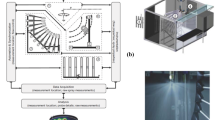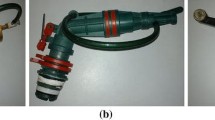Abstract
Measurements were conducted to characterize the spray patterns of an upright fire sprinkler in the near and far field of the sprinkler. The spatial distribution of droplet size, velocity and number density in the spray was measured using a laser-based shadow-imaging system. The water volume flux distribution was measured by an array of pressure-transducer-equipped water collection tubes and containers. A large-scale traverse was constructed to move the laser optics and water collection tubes and containers to the designated measurement locations. An upright fire sprinkler with a K-factor of 162 lpm/bar1/2, installed with its deflector 0.17 m below a flat horizontal ceiling, was characterized at two discharge pressures, i.e., 0.76 bar and 1.31 bar. In the near field at 0.76 m from the sprinkler, measurements were performed in a spherical coordinate at different azimuthal and elevation angles with respect to the sprinkler deflector. In the far field, the sprays were mapped out in a 110° circular sector at 3.05 m and 4.57 m below the ceiling. The shadow-imaging based water flux measurements were verified by the measurements obtained from water collection containers. Except for the pipe effect, the azimuthal distributions of the flow rate showed that the spray pattern was more influenced by the frame arms than by the deflector tines and slots. The gross droplet size distribution was expressed as a combination of a log-normal function and Rosin–Rammler function. The median droplet diameter was correlated as an empirical function of the sprinkler orifice diameter and operating pressure. The near-field distributions of the droplet size, velocity and flux can be used to prescribe the starting spray conditions for numerical simulations of spray transport. The far-field measurements are useful in evaluating the spray transport calculations.























Similar content being viewed by others
References
Yao C (1980) Extinguishing role of water sprinklers. In: Proceedings of the engineering applications of fire technology workshop. National Bureau of Standards, Gaithersburg, pp 51–88
Schwille JA, Lueptow RM (2006) The reaction of a fire plume to a droplet spray. Fire Saf J 41:390–398
Alpert RL (1985) Numerical modeling of the interaction between automatic sprinkler sprays and fire plumes. Fire Saf J 9:157–163
Bill RG Jr (1993) Numerical simulation of actual delivered density (ADD) measurements. Fire Saf J 20:227–240
McGrattan KB, Hostikka S, Floyd JE, Baum HR, Rehm RG (2007) Fire dynamics simulator (version 5) technical reference guide, NIST special publication 1018–5. National Institute of Standards and Technology, Gaithersburg
Zhou X, Yu HZ (2011) Experimental investigation of spray formation as affected by sprinkler geometry. Fire Saf J 46:140–150
Yu HZ (1986) Investigation of spray patterns of selected sprinklers with the FMRC drop size measuring system. In: Proceedings of the 1st international symposium on fire safety science. Hemisphere Publishing Corp., pp 1165–1176
Chan TS (1994) Measurements of water density and droplet size distributions of selected ESFR sprinklers. J Fire Prot Eng 6(2):79–87
Widmann JF (2001) Phase Doppler interferometry measurements in water spray produced by residential fire sprinklers. Fire Saf J 36:545–567
Sheppard DT (2002) Spray characteristics of fire sprinklers, NIST GCR 02-838. National Institute of Standards and Technology, Gaithersburg
Ren N, Marshall AW, Baum H (2011) A comprehensive methodology for characterizing sprinkler sprays. Proc Combust Inst 33(2):2547–2554
Kim KS, Kim SS (1994) Drop sizing and depth-of-field correction in TV imaging. At Sprays 4(1):65–78
Acknowledgments
This study was funded by FM Global in its sprinkler technology research program. The authors would like to thank Michael Gravel Jr. and Jeffrey Chaffee for setting up the facilities and conducting measurements.
Author information
Authors and Affiliations
Corresponding author
Additional information
A revised version submitted for a special issue of Fire Technology entitled “Automatic Suppression” under the invitation of the editor.
Rights and permissions
About this article
Cite this article
Zhou, X., D’Aniello, S.P. & Yu, HZ. Spray Measurements of an Upright Fire Sprinkler. Fire Technol 50, 457–482 (2014). https://doi.org/10.1007/s10694-012-0314-5
Received:
Accepted:
Published:
Issue Date:
DOI: https://doi.org/10.1007/s10694-012-0314-5




